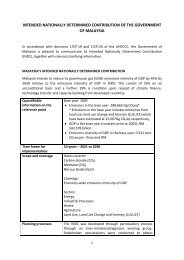RP-01638
RP-01638
RP-01638
You also want an ePaper? Increase the reach of your titles
YUMPU automatically turns print PDFs into web optimized ePapers that Google loves.
Overview of Technical<br />
Performance<br />
Goh Sing Yau<br />
After the Consumers' Association laboratory<br />
tests, a proposed design of the pumping<br />
element with a piston and a foot valve was<br />
accepted by the International Development<br />
Research Centre (IDRC) for testing in the<br />
IDRC Asian network of handpump projects.<br />
Development of the IDRC Design<br />
The piston assembly consists essentially of<br />
a polyvinyl chloride (PVC) piston with two<br />
polyethylene rings (see Fig. 1A). Laboratory<br />
tests were carried out in Thailand and<br />
Malaysia to determine the critical values of:<br />
(1) orificeipiston and orifice/foot valve area<br />
ratios; (2) valve weight; (3) valve gap;<br />
(4) stroke length; and (5) the stroke rate<br />
needed to obtain optimum performance as<br />
characterized by high volumetric and<br />
mechanical efficiencies. The results of the<br />
laboratory tests were incorporated into the<br />
modified versions of the piston (see fig. 6 of<br />
the Malaysian paper, page 45).<br />
Initial laboratory and field tests of the foot<br />
valve (see Fig. 1) in Thailand, Sri Lanka, and<br />
the Philippines showed that the original polyethylene<br />
cup seals did not provide an effective<br />
water-tight seal and leakage was excessive.<br />
To overcome this problem, a nonremovable<br />
foot valve (see fig. 7 of the Thailand paper,<br />
page 28) was used, with the foot valve solventwelded<br />
or bolted to the pump cylinder. Later,<br />
a double-lipped rubber seal was developed by<br />
the Malaysian group to replace the polyethylene<br />
cup seal for use in a removable foot valve<br />
(see fig. 6 of the Malaysian paper, page 45).<br />
The original IDRC design recommended a<br />
PVC or polyethylene valve flap. The use of<br />
these valve flaps caused excessive leakage<br />
that was particularly noticeable in the foot<br />
valve. The initial modification carried out by<br />
Thailand was to use a rubber disc with a brass<br />
backing-plate glued on to it. To prevent<br />
accumulation of sand at the valve seat,<br />
elevated lips were cut on the valve seat. The<br />
seal could be further improved with a spring<br />
to press the valve flap onto the seat. However,<br />
laboratory tests in Malaysia indicated<br />
that the spring-loaded valve flap increased<br />
the work input substantially and hence<br />
decreased the mechanical efficiency.<br />
It was discovered after several months of<br />
use that the glued-on brass backing-plate<br />
detached itself from the rubber disc. A further<br />
modification was subsequently successfully<br />
introduced in Thailand by replacing the<br />
previous valve flap design with a single<br />
rubber disk 0.25 inch (0.64 cm) thick without<br />
the backing plate or the spring. This modification<br />
was also found to be successful in the<br />
Malaysian project.<br />
In Sri Lanka, where there was difficulty in<br />
obtaining polyethylene rods, leather cup seals<br />
were used in place of polyethylene rings and<br />
cup seals.<br />
Development of the Above-Ground<br />
Components<br />
Different configurations of the aboveground<br />
components were used in the four<br />
countries; these are summarized in Table 1.<br />
The concrete pedestal adopted by the<br />
Philippines appears to be a simple, cheap<br />
alternative to the traditional pump stand.<br />
Timber lever handles (used in Malaysia and<br />
the Philippines) and timber/galvanized-iron<br />
bearings (used in model L3 in Sri Lanka and<br />
in Malaysia) have been found to be practical<br />
and durable. When cheap timber is available,<br />
timber components appear to be the obvious<br />
choice. The use of timber components also<br />
simplifies maintenance and repairs by handpump<br />
users at the village level.<br />
Field Tests<br />
A mid-project review meeting attended by<br />
investigators from each of the participating<br />
countries was held in Kuala Lumpur from 26-<br />
28 August 1980 to exchange experiences<br />
gained in laboratory and field tests and also to<br />
propose a common field-monitoring proce-<br />
53



